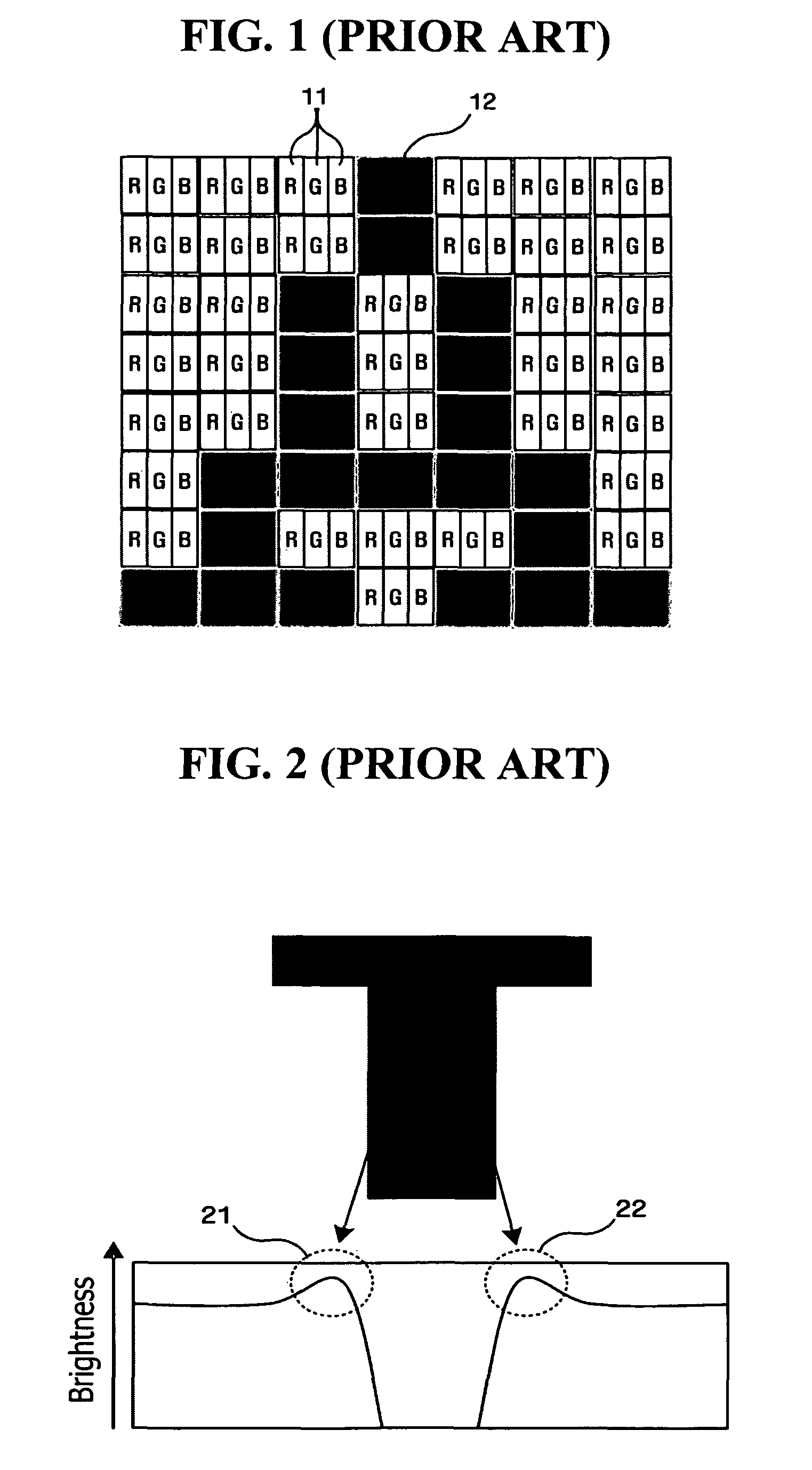Method and apparatus for displaying image signal
a technology of image signal and display method, applied in image analysis, image enhancement, instruments, etc., can solve the problems of inability to provide exact sub-pixel blending, color error bands are most noticeable, and not ideal for every application, so as to reduce the number of color error bands and increase the pixel size
- Summary
- Abstract
- Description
- Claims
- Application Information
AI Technical Summary
Benefits of technology
Problems solved by technology
Method used
Image
Examples
first embodiment
[0045]In the first embodiment, a method of changing a distorted sub-pixel component only is suggested as shown in FIG. 9. At the falling edge shown in (a) of FIG. 9, R component 91 of an input signal 72 is corrected to be decreased by a predetermined value so that an increased output pixel value can be corrected, while B component 92 of the input signal 72 is corrected to be increased by a predetermined value so that a decreased output pixel value can be corrected.
[0046]The decreased R component (R′) can be expressed as Equation (2) while the increased B component (B′) can be expressed as Equation (3). It is noted from Equation (2) that the correction range increases as the difference between current sub-pixels R(p) and B(p) and next sub-pixels R(p+1) and B(p+1) increases.
R′=α×{R(p)−R(p+1)}+R(p+1) (2)
B′=β×{B(p)−B(p+1)}+B(p+1) (3)
[0047]In Equation (2) and Equation (3), α and β are factors for determining the correction range and have a constant value between 0 and 1. The sum of α a...
second embodiment
[0049]In the second embodiment, a method of changing sub-pixel components adjacent to a distorted sub-pixel component while maintaining the distorted sub-pixel component is suggested as shown in FIG. 10. At the falling edge shown in (a) of FIG. 10, B and G components 101 which are sub-pixels adjacent to R component 91 are corrected to be increased by a predetermined value, whereby the B and G components become a similar level to the increased R component. An increased correction range of the B and G components 101 can have a value equal to a correction range obtained by Equation (2), i.e., |R′−R(p)|.
[0050]Likewise, G and R components 102 which are sub-pixels adjacent to B component 92 are corrected to be decreased by a predetermined value, whereby the G and R components become a similar level to the decreased B component. An decreased correction range of the G and R components 102 can have a value equal to a correction range obtained by Equation (3), i.e., |B′−B(p)|.
[0051]Meanwhile,...
third embodiment
[0053]In the third embodiment implemented by combination of the first embodiment and the second embodiment, a method of changing both a distorted sub-pixel component and sub-pixel components adjacent to the distorted sub-pixel component is suggested as shown in FIG. 11.
[0054]First, at the falling edge shown in (a) of FIG. 11, R component 91 is corrected to be decreased by a predetermined value and B and G components 101 which are sub-pixels adjacent to the R component 91 are corrected to be increased by a predetermined value, whereby all the components have the same level as one another.
[0055]For example, the decreased correction range is equal to the correction range of Equation (2), i.e., a value obtained by multiplying |R′−R(p)| and a predetermined coefficient γ while the increased correction range is equal to a value obtained by multiplying |R′−R(p)| and 1−γ, wherein γ has a constant value between 0 and 1. The third embodiment becomes identical with the first embodiment if γ is ...
PUM
 Login to View More
Login to View More Abstract
Description
Claims
Application Information
 Login to View More
Login to View More - R&D
- Intellectual Property
- Life Sciences
- Materials
- Tech Scout
- Unparalleled Data Quality
- Higher Quality Content
- 60% Fewer Hallucinations
Browse by: Latest US Patents, China's latest patents, Technical Efficacy Thesaurus, Application Domain, Technology Topic, Popular Technical Reports.
© 2025 PatSnap. All rights reserved.Legal|Privacy policy|Modern Slavery Act Transparency Statement|Sitemap|About US| Contact US: help@patsnap.com



